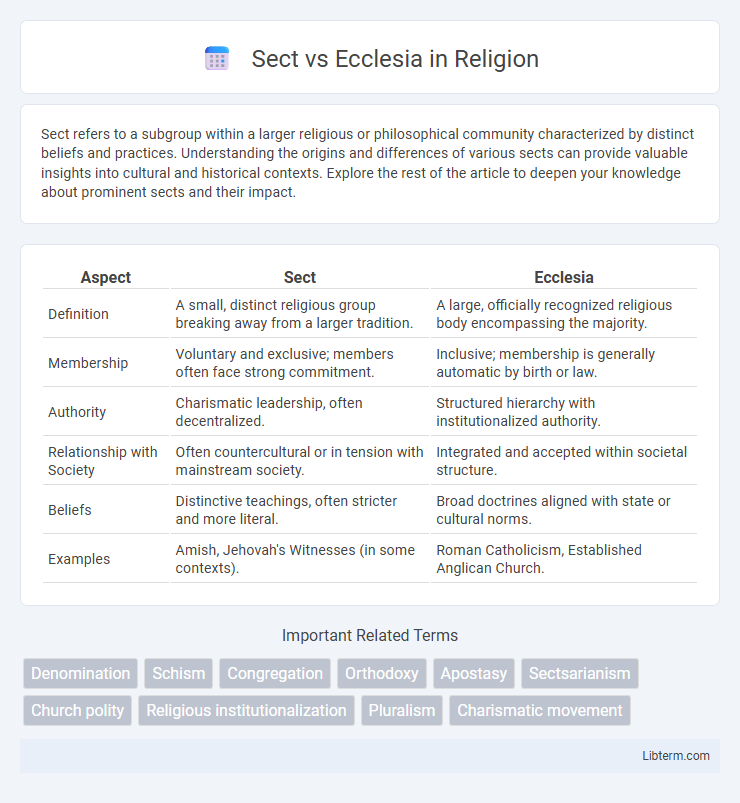Sect refers to a subgroup within a larger religious or philosophical community characterized by distinct beliefs and practices. Understanding the origins and differences of various sects can provide valuable insights into cultural and historical contexts. Explore the rest of the article to deepen your knowledge about prominent sects and their impact.
Table of Comparison
| Aspect | Sect | Ecclesia |
|---|---|---|
| Definition | A small, distinct religious group breaking away from a larger tradition. | A large, officially recognized religious body encompassing the majority. |
| Membership | Voluntary and exclusive; members often face strong commitment. | Inclusive; membership is generally automatic by birth or law. |
| Authority | Charismatic leadership, often decentralized. | Structured hierarchy with institutionalized authority. |
| Relationship with Society | Often countercultural or in tension with mainstream society. | Integrated and accepted within societal structure. |
| Beliefs | Distinctive teachings, often stricter and more literal. | Broad doctrines aligned with state or cultural norms. |
| Examples | Amish, Jehovah's Witnesses (in some contexts). | Roman Catholicism, Established Anglican Church. |
Defining Sect and Ecclesia
A sect is a religious group that breaks away from a larger established religion, often characterized by distinct beliefs and practices that set it apart, sometimes viewed as heretical or dissenting by mainstream followers. Ecclesia refers to the dominant religious organization within a society, officially recognized and closely integrated with the state or cultural norms, often encompassing the majority of the population. The key distinction lies in sects' separation and opposition to established doctrines, whereas ecclesias represent the accepted, institutionalized form of religion.
Historical Origins of Sects and Ecclesiae
Sects originated as dissenting groups breaking away from established religious traditions, often emphasizing stricter adherence to specific doctrines or practices, as seen in early Jewish sects like the Pharisees and Sadducees. Ecclesiae emerged as dominant, state-supported religious institutions, such as the early Christian Church institutionalized under Roman authority, promoting inclusive membership and formalized rituals. The historical development of sects versus ecclesiae reflects contrasting social dynamics, with sects frequently representing reformist or separatist movements and ecclesiae serving as recognized, authoritative bodies within societies.
Core Characteristics of a Sect
A sect is characterized by its exclusive membership, strict adherence to specific doctrines, and often a charismatic leadership that reinforces group cohesion and separation from mainstream society. Sects typically emerge as dissenting groups within a larger religious tradition, emphasizing purity and commitment over broad acceptance. Their core characteristics include intense social discipline, limited access to outside influences, and a strong sense of collective identity.
Key Features of an Ecclesia
An ecclesia is a large, institutionalized religious group that claims to include most members of a society and often enjoys state recognition or support. Key features of an ecclesia include formalized rituals, a well-established organizational structure, and alignment with the political order, integrating religion into the cultural mainstream. Unlike sects, ecclesiae maintain societal stability by promoting broadly accepted beliefs and values.
Membership and Social Structure
Sect membership typically consists of a smaller, tightly-knit group united by exclusive beliefs and rigorous commitment, fostering strong internal cohesion and distinct social boundaries. Ecclesia encompasses a broad, inclusive membership often integrated with the state or dominant culture, resulting in a hierarchical social structure with formal clergy and institutional governance. The sect's social structure emphasizes voluntary belonging and active participation, whereas ecclesia's structure supports passive membership through birthright or cultural affiliation.
Authority and Leadership Styles
Sect groups often emphasize charismatic authority, with leaders perceived as divinely inspired and maintaining strict, authoritarian control over members. Ecclesia represents institutional authority, featuring bureaucratic leadership structures that integrate religious authority with state power, promoting formalized rituals and hierarchical governance. The contrasting leadership styles impact group cohesion, with sect leadership fostering intense personal loyalty, while ecclesial leaders uphold tradition and social order.
Relationship with Broader Society
Sects often position themselves in opposition to broader society, emphasizing strict adherence to specific beliefs and practices that distinguish members from mainstream culture. Ecclesiae maintain an inclusive relationship with society, integrating religious life with prevailing social norms and institutions. The contrasting social dynamics shape how each group interacts with cultural, political, and social systems, influencing their acceptance and influence within society.
Role in Religious Change and Continuity
Sects often emerge as reform movements challenging established religious norms, driving significant change by introducing new beliefs or practices that can either evolve into independent denominations or dissolve over time. Ecclesia represents the dominant, institutionalized religion that maintains continuity by preserving core doctrines and integrating religious practices within the social and political framework of society. The dynamic interplay between sects and ecclesia shapes the ongoing transformation and stabilization of religious landscapes.
Examples of Sects and Ecclesiae Worldwide
Sects such as the Amish in the United States and the Sufis within Islam practice distinctive, often separatist beliefs that set them apart from mainstream society, emphasizing strict adherence to specific doctrines. Ecclesiae like the Roman Catholic Church and the Church of England hold official or semi-official status within nations, integrating closely with broader societal institutions and cultural identity. These examples demonstrate the sect's tendency toward exclusivity and counter-cultural distinctiveness, contrasted with the ecclesia's role as an accepted and dominant religious institution.
Sect vs Ecclesia: Sociological Implications
Sect and ecclesia represent distinct forms of religious organization with significant sociological implications. Sects are voluntary, often dissenting groups formed in opposition to broader societal norms, emphasizing exclusivity and strict adherence to doctrine, which can lead to social tension and potential marginalization. Ecclesia, by contrast, are inclusive, state-endorsed religious bodies that integrate closely with societal institutions, promoting social cohesion and stability.
Sect Infographic

 libterm.com
libterm.com